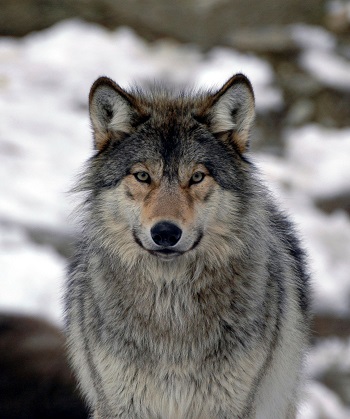
The Northwestern Wolf (Canis lupus occidentalis), also known as the Mackenzie Valley wolf, stands as an emblem of untamed wilderness, embodying the fierce beauty of the northern landscapes it calls home. As a subspecies of the gray wolf, the Northwestern Wolf is distinguished by its unique characteristics, including its native habitat and range, as well as exceptional individuals that have left an indelible mark on the natural world.
Native Habitat and Range
The Northwestern Wolf’s heart beats in the vast expanse of North America, primarily inhabiting the forests, mountains, and tundra of the western region. Stretching from Alaska to the western portions of Canada and even reaching into the northwestern United States, this majestic creature has thrived in some of the continent’s most challenging environments.
In its native habitat, the Northwestern Wolf often finds solace within dense coniferous forests, where it can seamlessly blend with the shadows and navigate through the underbrush. From the towering peaks of the Rocky Mountains to the remote wilderness of Alaska, these wolves have adapted to a range of ecosystems, showcasing their resilience and adaptability.
Average Specimens
The Northwestern Wolf is characterized by its stunning blend of gray, black, and brown fur, which offers excellent camouflage in its surroundings. On average, adult males stand at around 2.5 to 3 feet tall (at the shoulder) and measure approximately 5.5 to 6.5 feet in length, including their bushy tails. Females tend to be slightly smaller. These wolves typically weigh between 70 to 135 pounds, with males generally being larger than females.
Record-Sized Specimens
While the average size of the Northwestern Wolf is awe-inspiring, there are exceptional individuals that have captured the imagination of researchers and wildlife enthusiasts alike:
The Yukon Giant: In 2007, a wolf was captured in the Yukon Territory of Canada that set a record for its extraordinary size. This male wolf weighed a staggering 175 pounds, making it one of the largest wild wolves ever recorded.
The Legendary Wolves of Isle Royal: Isle Royale National Park, situated in Lake Superior, is home to a population of Northwestern Wolves that has undergone extensive study. One of the wolves captured and documented on the island held a place in the record books, weighing approximately 140 pounds.
Ecological Significance
The Northwestern Wolf plays a pivotal role in maintaining ecosystem balance. As apex predators, they help regulate prey populations, ensuring that herbivores do not overgraze vegetation. Additionally, their presence can impact the behavior and distribution of other wildlife species, influencing the intricate web of life within their habitats.
Conservation Challenges and Efforts
Despite their significance, Northwestern Wolves have faced challenges related to habitat loss, human-wildlife conflicts, and historical predator control programs. However, many conservation organizations and government agencies are working diligently to protect and restore wolf populations through habitat preservation, scientific research, and public education.
Conclusion
The Northwestern Wolf stands as a testament to the wild and untamed spirit of North America’s western landscapes. Its distinctive features, habitat, and remarkable size make it an inspiring creature that holds a crucial place within the intricate tapestry of nature.
7 Fun Facts About the Northwestern Wolf
Social Structure: Northwestern wolves are highly social animals that live in packs. A typical pack consists of an alpha male and female (the breeding pair), along with their offspring of various ages. The pack structure is important for hunting, protection, and overall survival.
Communication: Wolves are known for their complex vocalizations. They communicate through howls, barks, growls, and whines, which serve various purposes such as alerting pack members, marking territory, and coordinating hunts.
Diet: These wolves are carnivores and primarily feed on ungulates (hooved animals) like caribou, moose, deer, and occasionally smaller mammals like beavers and hares. Their hunting strategy often involves teamwork and coordination within the pack.
Keystone Predators: Northwestern wolves play a significant role in maintaining ecosystem balance. By controlling the population of prey species, they prevent overgrazing and help to ensure the health of the plant community.
Conservation Status: The Northwestern wolf is not listed as a separate subspecies under most classification systems, but rather falls under the broader classification of gray wolves. However, gray wolves in some regions have faced habitat loss and conflicts with humans, leading to localized conservation efforts.
Mythology and Culture: Wolves have held a special place in the mythologies and cultures of many indigenous North American tribes. They are often depicted as powerful and wise creatures in stories and ceremonies.
Role in Research: Wolves, including the Northwestern wolf, have been subjects of extensive research to understand their behavior, ecology, and impact on ecosystems. This research helps conservationists and scientists make informed decisions about wolf management and habitat protection.
Related Articles & Free Email Newsletter Sign Up
Desert Bighorn Sheep are Masters of Arid Landscapes
The American Alligator: A Vital Component of Ecosystem Balance




Comment here